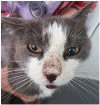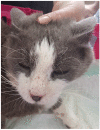Effectiveness of a fluralaner spot-on formulation in a case of feline demodicosis due to Demodex cati
- PMID: 35111330
- PMCID: PMC8801658
- DOI: 10.1177/20551169211069529
Effectiveness of a fluralaner spot-on formulation in a case of feline demodicosis due to Demodex cati
Abstract
Case summary: A 7-year-old male domestic shorthair cat was presented with a non-pruritic erythematous crusted nasal hypotrichosis along with bilateral ceruminous otitis externa. The cat was diagnosed with diabetes mellitus and was positive for feline immunodeficiency virus (FIV). Deep skin scraping, trichograms from lesional skin and ear canal parasitological examination were positive for Demodex cati. A 250 mg (55.5 mg/kg) fluralaner spot-on for medium-sized cats (Bravecto; MSD) was applied to the base of the cat's head. Re-examinations were carried out on the fourth, sixth and eighth weeks after therapy. On the fourth week, the ceruminous otitis had resolved completely and the nasal lesions were markedly improved. One dead adult D cati was found in deep skin scrapings while other tests from the skin and both ear canals were negative. On the second re-examination only a mild hypotrichosis persisted on the nasal region and all parasitological examinations were negative. Eight weeks after the initial examination, the skin lesions had almost clinically resolved. On the 12th week, fluralaner spot-on was repeated. No recurrence was noted at the 6-month follow-up.
Relevance and novel information: The use of isoxazolines has been reported for only a few demodectic cats but was described to be safe and effective. This is the first report to evaluate the efficacy of a single spot-on fluralaner for the treatment of localised dermatitis and otodemodicosis due to D cati, and suggests it as an effective, safe and practical treatment.
Keywords: Demodex cati; demodicosis; fluralaner; isoxazolines; otodemodicosis.
© The Author(s) 2022.
Conflict of interest statement
Conflict of interest: The authors declared no potential conflicts of interest with respect to the research, authorship, and/or publication of this article.
Figures
Similar articles
-
Successful treatment of non-pruritus, excessive hair shedding and scales in a cat due to Demodex gatoi with fluralaner topical spot-on.JFMS Open Rep. 2024 May 14;10(1):20551169241246866. doi: 10.1177/20551169241246866. eCollection 2024 Jan-Jun. JFMS Open Rep. 2024. PMID: 38751448 Free PMC article.
-
Successful treatment of otodemodicosis due to Demodex cati with sarolaner/selamectin topical solution in a cat.JFMS Open Rep. 2021 Jan 28;7(1):2055116920984386. doi: 10.1177/2055116920984386. eCollection 2021 Jan-Jun. JFMS Open Rep. 2021. PMID: 33598306 Free PMC article.
-
Feline Demodicosis Case Report-First Molecular Characterization of Demodex Mites in Romania.Pathogens. 2021 Nov 12;10(11):1474. doi: 10.3390/pathogens10111474. Pathogens. 2021. PMID: 34832631 Free PMC article.
-
Diagnosis and treatment of demodicosis in dogs and cats: Clinical consensus guidelines of the World Association for Veterinary Dermatology.Vet Dermatol. 2020 Feb;31(1):5-27. doi: 10.1111/vde.12806. Vet Dermatol. 2020. PMID: 31957202 Review.
-
Review of extralabel use of isoxazolines for treatment of demodicosis in dogs and cats.J Am Vet Med Assoc. 2020 Jun 15;256(12):1342-1346. doi: 10.2460/javma.256.12.1342. J Am Vet Med Assoc. 2020. PMID: 32459587 Review.
Cited by
-
Successful treatment of non-pruritus, excessive hair shedding and scales in a cat due to Demodex gatoi with fluralaner topical spot-on.JFMS Open Rep. 2024 May 14;10(1):20551169241246866. doi: 10.1177/20551169241246866. eCollection 2024 Jan-Jun. JFMS Open Rep. 2024. PMID: 38751448 Free PMC article.
-
Isoxazolines for treating canine and feline otodectic mange; feline demodicosis, lynxacariasis, lice infestation, and notoedric mange (scabies); demodicosis in hamsters; and sarcoptic and psoroptic manges in rabbits.Can Vet J. 2023 Nov;64(11):1066-1070. Can Vet J. 2023. PMID: 37915780 Free PMC article. No abstract available.
-
Sarolaner/selamectin spot-on: An effective treatment of generalized demodicosis due to Demodex cati in a cat.Can Vet J. 2025 Aug 1;66(8):843-846. eCollection 2025 Aug. Can Vet J. 2025. PMID: 40786743
-
A systematic review of fluralaner as a treatment for ectoparasitic infections in mammalian species.PeerJ. 2025 Mar 12;13:e18882. doi: 10.7717/peerj.18882. eCollection 2025. PeerJ. 2025. PMID: 40093406 Free PMC article.
References
-
- Bizikova P. Localized demodicosis due to Demodex cati on the muzzle of two cats treated with inhalant glucocorticoids. Vet Dermatol 2014; 25: 222–225. - PubMed
-
- Mueller RS, Rosenkrantz W, Bensignor E, et al.. Diagnosis and treatment of demodicosis in dogs and cats: clinical consensus guidelines of the World Association for Veterinary Dermatology. Vet Dermatol 2020; 31: 4–26. - PubMed
-
- Guaguere E, Muller A, Degorce-Rubiales F. Feline demodicosis: a retrospective study of 12 cases [abstract]. Vet Dermatol 2004; 15: S34.
-
- Poucke SV. Ceruminous otitis externa due to Demodex cati in a cat. Vet Rec 2001; 149: 651–652. - PubMed
Publication types
LinkOut - more resources
Full Text Sources
Miscellaneous


